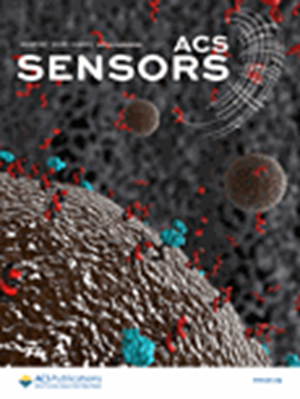利用纳米酶的热稳定性进行焦耳加热以去除横向流动分析中的背景过氧化物酶活性
IF 8.2
1区 化学
Q1 CHEMISTRY, ANALYTICAL
引用次数: 0
摘要
横向流动测定法(LFAs)对于即时检测至关重要。利用模拟过氧化物酶的纳米酶作为催化标签是LFA的一个积极发展方向,主要集中在提高灵敏度上。然而,天然存在于各种样品中的内源性过氧化物酶会干扰纳米酶信号放大,导致高背景信号,使视觉检测更具挑战性。内源性过氧化物酶的问题对lfa作为无水洗生物传感器尤为重要。在这项研究中,我们展示了纳米酶与酶相比的显著热稳定性,应用于黄曲霉毒素B1检测的横向流动分析相关使用。通过在便携式电池供电装置中使用焦耳加热,在完成常规LFA过程后,将测试条快速加热到75-80°C。这种加热引起内源性过氧化物酶的热变性而不影响Au@Pt纳米酶。结果,测试条上的底物氧化仅由Au@Pt纳米酶进行,这减少了背景噪声,与不加热的分析相比,检测限提高了3.5倍。本文章由计算机程序翻译,如有差异,请以英文原文为准。

Utilizing the Thermostability of Nanozymes for Joule Heating to Remove Background Peroxidase Activities in Lateral Flow Assays
Lateral flow assays (LFAs) are essential for point-of-care testing. The use of peroxidase-mimicking nanozymes as catalytic labels is an actively developing direction in LFA, primarily focused on enhancing sensitivity. However, endogenous peroxidases, naturally present in various samples, can interfere with nanozyme signal amplification, leading to a high background signal and making visual detection more challenging. The issue of endogenous peroxidases is particularly significant for LFAs as wash-free biosensors. In this study, we showcase the remarkable thermostability of nanozymes in contrast to enzymes, applied to the analytically relevant use of lateral flow assays for the detection of aflatoxin B1. By employing Joule heating in a portable battery-powered device, the test strips were rapidly heated to 75–80 °C after completing the conventional LFA process. This heating caused thermal denaturation of endogenous peroxidases without affecting the Au@Pt nanozymes. As a result, substrate oxidation on the test strip was carried out solely by the Au@Pt nanozymes, which reduced background noise and improved the limit of detection by a factor of 3.5 compared to the assay without heating.
求助全文
通过发布文献求助,成功后即可免费获取论文全文。
去求助
来源期刊

ACS Sensors
Chemical Engineering-Bioengineering
CiteScore
14.50
自引率
3.40%
发文量
372
期刊介绍:
ACS Sensors is a peer-reviewed research journal that focuses on the dissemination of new and original knowledge in the field of sensor science, particularly those that selectively sense chemical or biological species or processes. The journal covers a broad range of topics, including but not limited to biosensors, chemical sensors, gas sensors, intracellular sensors, single molecule sensors, cell chips, and microfluidic devices. It aims to publish articles that address conceptual advances in sensing technology applicable to various types of analytes or application papers that report on the use of existing sensing concepts in new ways or for new analytes.
 求助内容:
求助内容: 应助结果提醒方式:
应助结果提醒方式:


